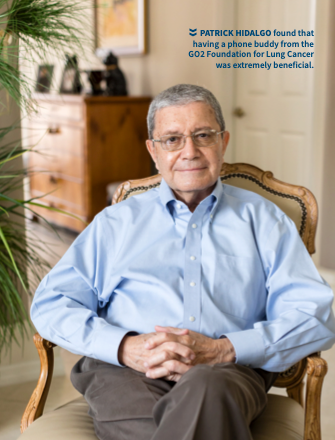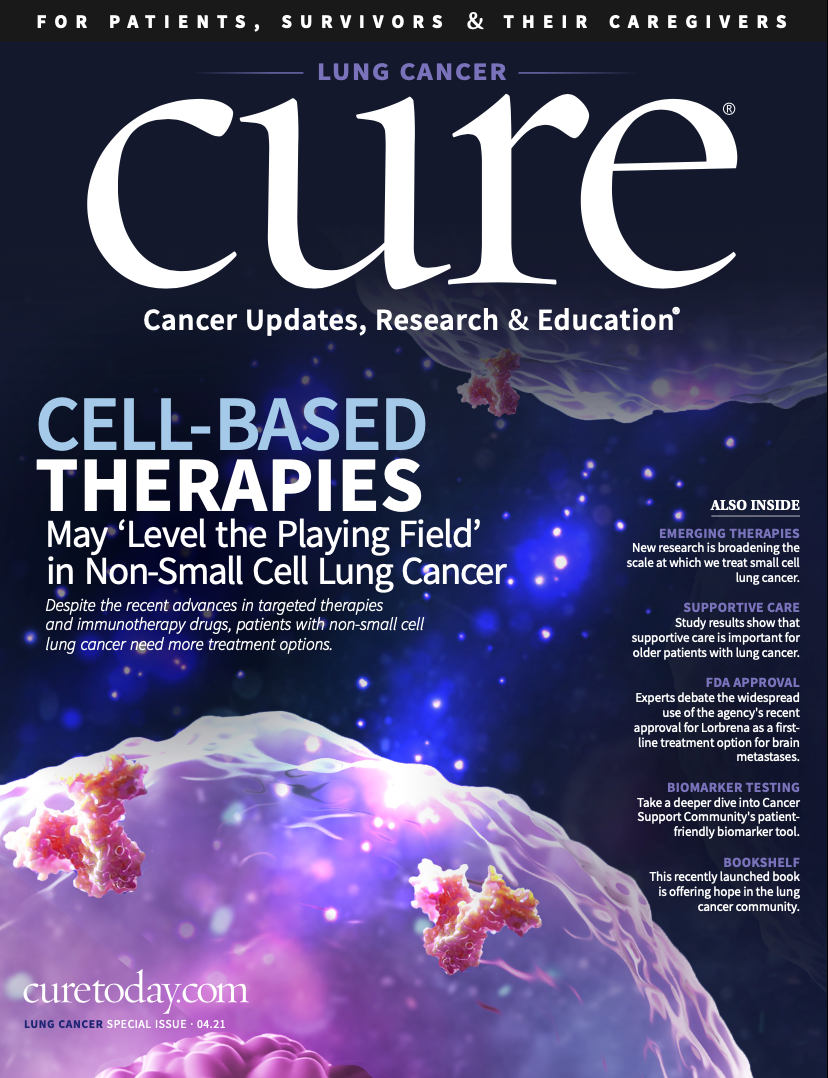Publication
Article
CURE
Early Introduction to Supportive Care Greatly Benefits Older Patients With Lung Cancer
Author(s):
Because of their age, disease state and comorbid conditions, older patients need supportive care.
When Frank Giunta, 82, of Collegeville, Pennsylvania, was diagnosed with non-small cell lung cancer (NSCLC) in August 2020, he was assured by his caregivers at Penn Medicine’s Abramson Cancer Center in Philadelphia that he would not be alone during his treatment journey. Accompanying him would be a multidisciplinary supportive care team dedicated to ensuring that everything went smoothly, with as little impact as possible on his quality of life.
Giunta’s treatment was complex. He received more than 30 proton radiation treatments and multiple sessions of chemotherapy. A feeding tube was inserted when esophagitis from the radiation treatments made swallowing painful. He spent 17 days in the hospital, and three days after he returned home, his wife died from complications of lung and breast cancer.
“It was a difficult journey made more comfortable by supportive care,” Giunta says. A nurse visited twice a week and taught his two daughters how to care for him. A physical therapist assisted with balance issues, and a speech therapist helped him overcome swallowing difficulties related to the esophagitis.
“I wouldn’t have known what to do without supportive care,” Giunta says. “They made my life and recovery much easier.”
Giunta’s experience is typical among patients with lung cancer, who tend to skew older. According to the American Society of Clinical Oncology, the average age at the time of diagnosis for advanced lung cancer is 70. This age group also tends to have more comorbidities that can affect treatment type, outcomes and quality of life. The good news: A growing body of research suggests that the early introduction of supportive care greatly benefits older patients with lung cancer physically, emotionally and psychologically.
“Supportive care is essentially the many different measures we put in place to take care of the whole person,” says Dr. Christine Ciunci, an assistant professor of clinical medicine and section chief of hematology-oncology at Penn Presbyterian Medical Center. “We provide treatments, either curative or palliative, to help patients live the best life that they can and feel their best for the longest amount of time possible. It’s a multidisciplinary approach that includes cancer treatments as well as the prevention and treatment of side effects, social work, nutrition, physical therapy, speech therapy, home care, palliative care and management of comorbidities such as COPD, heart disease and diabetes. Supportive care encompasses all of these things and is what I spend a lot of focus on as a thoracic medical oncologist.”
Supportive care for older patients with lung cancer has evolved in recent years as researchers explore its need, scope and efficacy. Key aspects are a greater appreciation of the complexity of cancer care and the increased role of supportive care throughout the process, says Dr. Arif Kamal, an associate professor of medicine at Duke University School of Medicine and a member of the Duke Cancer Institute in Durham, North Carolina. “Referral to a specialist, such as an endocrinologist for diabetes, makes sense because it’s good care to provide that extra layer of support to the patient,” he explains. “Cancer care delivery in 2021 is a team sport, and as a team sport, we can’t be shy about asking for help when we need it.”
Equally important is acknowledgement that supportive care is most effective when started early in the treatment process. Helping to drive this concept are the findings of a seminal 2010 study published in the New England Journal of Medicine, which found that among patients with metastatic NSCLC, early palliative care led to big improvements in quality of life and mood. In addition, compared with patients receiving standard care, patients receiving early palliative care had less aggressive care at the end of life but longer survival.
“Over the years, palliative care has evolved and become a standard of care for these patients,” Ciunci says “We have more options to help patients and more supportive measures in place than we did even just a few years ago. It has been very beneficial for our patients.”
Supportive care goes by a number of different names, Kamal notes. The majority of programs call themselves palliative care, some call themselves supportive and palliative care, and others call themselves supportive care only. Among them, the services are essentially the same. “We advocate for multidisciplinary care that involves physicians, nurses, chaplains and social workers, at a minimum, but also care navigators, physical therapists and others,” Kamal says. “We find large variability across the country.”
Patients with lung cancer commonly require more supportive care than patients with other types of cancer due to their age, the stage of their disease and the presence of comorbid conditions, sometimes including intrinsic lung disease. “Patients with lung cancer can have significant symptom burden at the time of diagnosis, especially those with metastatic disease,” notes Dr. Robert Daly, a thoracic medical oncologist at Memorial Sloan Kettering Cancer Center (MSK) in New York City. “They can have underlying pain from their metastases, as well as fatigue, loss of appetite, shortness of breath and cough, so there is a clear need within this patient population.”
Patients with lung cancer may also experience psycho- logical and emotional issues related to existential distress. Former smokers, for example, may feel depressed because they blame their lifestyle for their cancer. Others may experience conflict with their spirituality, questioning why they developed cancer despite living a healthy life, or believing that their cancer is some sort of punishment. Kamal recalls a patient who had received an abortion in her teens and refused pain management for her cancer because she felt she had to atone for her perceived sin.
“I don’t have the skills to deal with that, but I do have people on my team, such as chaplains, who do,” Kamal says. “It affects everything.”

Not all patients experience a crisis of faith, however. Patrick Hidalgo, 79, of Boynton Beach, Florida, turned to prayer to help him deal with post-operative pain and other issues following a diagnosis of stage 3A lung cancer in May 2020. “I don’t like taking drugs, and prayer was very effective for me,” Hidalgo says.
A patient’s need for supportive care is commonly deter- mined through a close assessment of their disease, symptoms, physical condition, home support, transportation options and much more. Through candid conversation, the supportive care team can help the patient determine their specific goals, whether curative or palliative, and create a plan to achieve those goals.
“The medical oncologist works closely with the patient to manage their symptoms, from the disease and from any toxicities resulting from treatment,” Daly explains. “But involvement of a supportive care specialist also helps benefit the patient by integrating their expertise with that of the medical oncologist.”
Supportive care is typically tailored to the patient, though certain aspects are common to all, Ciunci says. These include addressing the side effects of treatment and ensuring access to a social worker. “This is important to ensure the patient has all the resources they need at home,” Ciunci explains. “Home care is highly valued for these patients.”
Hidalgo received post-surgical wound care through a visiting nurse, who also taught Hidalgo’s wife, Josie, how to help him as needed. In addition, a physical therapist placed him on an exercise regimen to keep his body strong while he healed. The process was an eye-opener. “I was in great shape,” Hidalgo says. “I was riding a bike 10 miles a day. Then I got sick and everything changed.”
The early introduction of supportive care can have a positive effect on treatment outcomes and quality of life. “There are good studies that show that timing does matter,” says Kamal. “When we think about best-practice palliative and supportive care, we are talking within 12 weeks of diagnosis. The reason for that is, an ounce of prevention is worth a pound of cure when we talk about distress. If we start supportive care at the same time we start treatment, we can prevent complications from happening, anticipate them and have a plan in place to manage them. This keeps the patient from having to go to the emergency room at 2 a.m. when the pain worsens.”

Older patients with lung cancer sometimes encounter barriers to receiving supportive care. A lack of transportation is one of the most common, especially for those who may depend on family, friends or public transportation to get around. Many cancer centers have turned to telehealth to make visits with doctors and other care providers easier but, as Ciunci notes, a large percentage of older people do not have smartphones or laptops. “It can sometimes be difficult to connect patients to these valuable resources due to a lack of comfort with certain technologies,” she observes.
Financial difficulties also can be an obstacle to supportive care, Ciunci says. A patient who is seen by the oncology team once a week, for example, may be overburdened if required to return for a palliative care visit or physical therapy session on a separate day. Financial issues may include the expense of child care, lost work time, and even the cost of gas and parking. Additionally, many patients cannot afford certain basics integral to their care, such as nutritional supplements and home health equipment.
“We may be able to provide access to samples, coupons and programs, but it doesn’t take care of everything,” Ciunci says. “Some patients may be reluctant to come in for visits because they simply can’t afford the copay. Luckily, at Penn Medicine, we are able to offer financial assistance and specialized resources, but not every program can.”
Over the past year, patients with lung cancer faced another unexpected obstacle: the COVID-19 pandemic. When it came time for him to begin chemotherapy, Hidalgo decided to have it done at MSK, where COVID-19 cases were dropping, rather than in Florida, where cases were spiking. The supportive care he received from his oncology team at MSK was primarily process oriented, he says, as they guided him through the realities of treatment, side effects and more.
Supportive care is an essential key to the effective treatment of lung cancer, and older patients are encouraged to become their own advocates. “My advice is for patients to ask their oncology team early and often about supportive and palliative care resources, to add all the extra layers of support they can to their team, so that several minds are thinking about their distress from all angles,” Kamal says. “I would ask (as a patient), ‘What supportive or palliative care resources do you think could help me?’ and predicate the question on a clear and mutual understanding of what quality-of-life issues the patient and their family are facing. If everyone isn’t on the same page, there is a real risk of the oncologist underappreciating the unmet needs that can be addressed through additional services.”
Find a team that you work well with, Ciunci adds. “Your oncologist should be asking, ‘What are your goals for your cancer treatment, and what do you want for the future?’ I think that’s extremely important so that your team can tailor your treatment approach based on your objectives,” she notes. “And of course, if you haven’t been given access to a social worker, nutritionist, physical therapist or palliative care provider, you should ask. These are things that should be readily available to you during treatment.”
From a patient perspective, Hidalgo encourages others to reach out to support organizations such as the GO2 Foundation for Lung Cancer. Hidalgo benefited greatly from a phone buddy there and now works in a similar capacity helping others. “My interaction with the GO2 Foundation was the most impactful component of my recovery,” he says. “Now I help out by reaching out to others in the lung cancer community.”
For more news on cancer updates, research and education, don’t forget to subscribe to CURE®’s newsletters here.





